![]()
![]()
![]()
Use LEFT and RIGHT arrow keys to navigate between flashcards;
Use UP and DOWN arrow keys to flip the card;
H to show hint;
A reads text to speech;
73 Cards in this Set
- Front
- Back
|
Useful field characteristics for Betulaceae.
|
trees or shrubs
leaves simple, alternate Doubly serrate monoecious plants pistillate and staminate flowers in separate catkins ovary inferior nut, samara |
|
|
Characteristics of Betulaceae
|
1) trees or shrubs - mostly north temperate
2) Leaves simple, alternate, usually with doubly serrate margins 3) Flowers unisexual; plants monoecious - flowers subtended by bracts; sometimes 2 or more - flowers of both sexes usually in catkins (sometimes males only- Corylus) - tepals 1-4, sometimes lacking and always very reduced - stamens 1-4; carpels 2(-3) fused - ovary inferior 4) fruit: nut (animal dispersed) or samara (wind dispersed) nut: hard, dry, indehiscent, usually with a single seed |
|
|
Characteristics of Fagaceae
|
1) trees or shrubs - mostly northern hemisphere, temperate to subtropical
2) leaves simple, alternate 3) Flowers unisexual; plants monoecious - tepals usually 6; always very reduced - male flowers in catkins; 4-40 stamens per flower - female flowers solitary or clustered in leaf axils; carpels 3-6, connate; surrounded by an involucre of several overlapping bracts - ovary inferior - of 3 fused carpels, each with 2 ovules; all but one ovule aborts 4) Fruit: nut (animal dispersed) |
|
|
Useful field characteristics of Fagaceae
|
trees or shrubs
leaves simple, alternate monoecious plants pistillate flowers in leaf axils staminate flowers in catkins ovary inferior nut with involucre of bracts |
|
|
Betulaceae
Male and female catkins Alnus |
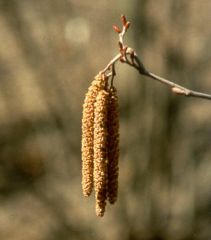
Identify the family and name the key characteristics
Identify the genus and species if known |
|
|
Betulaceae
Female flowers develop into cone. Alnus |

Identify the family and name the key characteristics
Identify the genus and species if known |
|
|
Betulaceae
Male Alnus flowers Alnus |
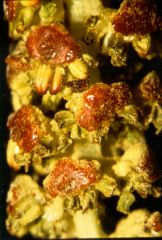
Identify the family and name the key characteristics
Identify the genus and species if known |
|
|
Betulaceae
Betula leaves - doubly serrate Betula |
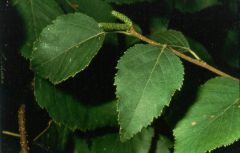
Identify the family and name the key characteristics
Identify the genus and species if known |
|
|
Betulaceae
Betula samara - winged fruit Betula |
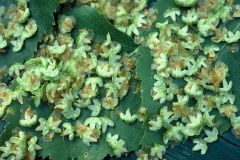
Identify the family and name the key characteristics
Identify the genus and species if known |
|
|
Fagaceae
Quercus catkins |
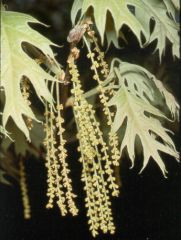
Identify the family and name the key characteristics
Identify the genus and species if known |
|
|
Fagaceae
Quercus female flowers |
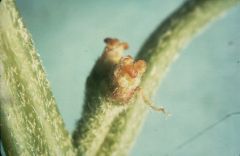
Identify the family and name the key characteristics
Identify the genus and species if known |
|
|
Fagaceae
Quercus involucre |
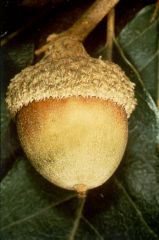
Identify the family and name the key characteristics
Identify the genus and species if known |
|
|
Fagaceae
Quercus male flowers |
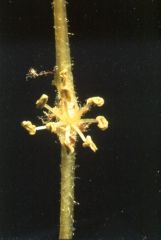
Identify the family and name the key characteristics
Identify the genus and species if known |
|
|
Characteristics of Salicaceae
|
1) shrubs and trees
Vegetative reproduction by root sprouts (e.g., aspen groves) or rooting of branches (e.g.,willows along streams) common. The largest single living ‘organism’ is an aspen grove in Utah 2) lvs simple 3) Dioecious - separate male and female plants 3) Flowers in catkins (both male and female) – pussy willows - fls borne in axil of hairy bracts on catkin axis - no perianth (sepals and petals) - ovary superior, with 2-4 fused carpels with many ovules (different from oaks and birches, which are inferior and with 1-few ovules) 4) seeds hairy - hence “cottonwood” Floral formulae: female: * 0, 0, 0, 2-4 capsule [carpels fused] male: * 0, 0, 2-∞, O |
|
|
Useful field characteristics of Saliceae
|
trees or shrubs
dioecious plants pistillate and staminate flowers in separate catkins seeds numerous and comose (hairy) |
|
|
Characteristics of Caryophyllaceae.
|
1) Repeat after me: opposite leaves, swollen nodes
2) herbaceous 3) floral parts in 5s petals often with well developed claw (forming tube) and blade - ovary of 2-5 carpels - placentation usually free-central (basal, axile) 4) NO BETALAINS |
|
|
Useful field characteristics of Caryophyllaceae
|
herbs
leaves simple, opposite swollen nodes petals entire to deeply lobed, often differentiated into a claw and a limb floral parts in 5's placentation often freecentral |
|
|
Characteristics of Cactaceae
|
1) habit: succulent stems, variously shaped, sometimes flattened
- Primitive cacti are vines or shrubs and are not succulent. 2) leaves are ephemeral or reduced axillary buds, called Areoles, with leaves in the form of spines: Glochidia. 3) Flowers exhibit a secondary increase in the number of parts - many tepals usually united at the base into a hypanthium - many stamens arising from the hypanthium - inferior ovary of 3-∞ fused carpels; placentation parietal |
|
|
Useful field characteristics of cactaceae
|
stem succulents
areoles flowers showy floral parts numerous ovary inferior placentation usually parietal |
|
|
Characteristics of Portulaceae.
|
1) herbs, plants often somewhat succulent
2) lvs simple, alternate or opposite, often fleshy (almost succulent) 3) flowers - Characteristic paired bracts, usually called sepals, beneath each flower - petals (really tepals, because ‘sepals’ are really bracts) - 5 or more - Lewisia is an important exception here in PNW with many (2-9) sepaloid bracts and many tepals. BETALAINS |
|
|
Useful field characteristics of Portulaceae
|
usually herbs
2 to several sepals plants often fleshy leaves simple, opposite or alternate basal placentation |
|
|
Characteristics of Polygonaceae
|
1) Herbaceous or woody (mostly in the tropics)
2) lvs simple alternate; with sheathing stipules (derived from the stipules) called an Ocrea 3) Flowers 3-parted - tepals usually 6 (sometimes 5) - stamens 6-9 4) NO BETALAINS |
|
|
Useful field characteristics of Polygonaceae
|
leaves alternate, with sheathing stipules (ocreas)
one floral envelope achene, often winged |
|
|
Salicaceae
Populars or cottonwood Populus trichocarpa |
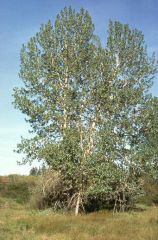
Identify the family and name the key characteristics
Identify the genus and species if known |
|
|
Salicaceae
Fruit is capsule with hairy seeds Salix |
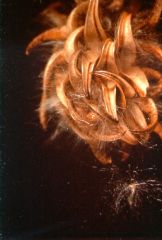
Identify the family and name the key characteristics
Identify the genus and species if known |
|
|
Characteristics of Fabaceae/Legumonoceae
|
trees, shrubs or herbs
leaves often compound leaflets with entire margins stamens numerous to 10, diadelphous in papilionaceous flowers carpel 1 (per flower) legume or loment |
|
|
Fabaceae
Many stamens, 1 carpel. Mimosoideae subfamily Albizzia |
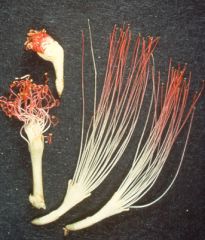
Identify the family and name the key characteristics
Identify the genus and species if known |
|
|
Fabaceae
Caesalpinoid "flag" flower with five petals - Flag, two wings, and not fused keel, 10 stamens, not fused. Cassia |
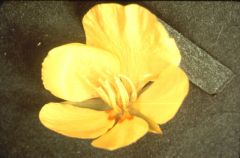
Identify the family and name the key characteristics
Identify the genus and species if known |
|
|
Fabaceae
Caesalpinoid "flag" flower with five petals - Flag, two wings, and not fused keel, 10 stamens, not fused. Cercis |
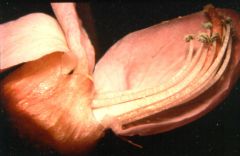
Identify the family and name the key characteristics
Identify the genus and species if known |
|
|
Fabaceae
Papilionoid "flag" flower with five petals, flag, 2 wings and 2 fused keels, 10 stamen, 9 fused together. Lathyrus |
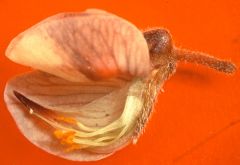
Identify the family and name the key characteristics
Identify the genus and species if known |
|
|
Fabaceae
Papilionoid "flag" flower with five petals, flag, 2 wings and 2 fused keels, 10 stamen, 9 fused together Lathyrus |
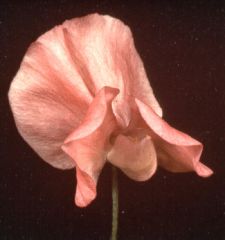
Identify the family and name the key characteristics. Identify the genus and species if known.
|
|
|
Fabaceae
Compound leaves, entire margins, papilionoid flowers Lupinus |
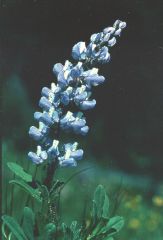
Identify the family and name the key characteristics. Identify the genus and species if known.
|
|
|
Fabaceae
Legume fruit - characteristic of all in the family. Lupinus |
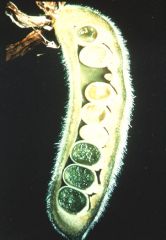
Identify family and name key characteristics. Identify genus and species if known.
|
|
|
Useful field characteristics of Violaceae.
|
usually herbs
flowers zygomorphic corolla polypetalous, spurred nectar guides stamens connivent |
|
|
Useful field characteristics of Asteraceae
|
head or capitulum, surrounded by phyllaries
disk or disk and ray or ligulate flowers pappus corolla sympetalous anthers syngenesious (connate) ovary inferior achene (cypsela) |
|
|
Characteristics of Asteraceae
|
1) all life forms, but mostly herbs
2) lvs usually simple, without stipules; alt or opp 3) Inflorescence a capitulum or ‘head’, surrounded by involucral bracts (pseudanthium) The alternate name for this family, Compositae, recognizes the ‘composite’ nature of the ‘flowers’; each unit made up of many small flowers 4) flowers borne on a flat to conical receptacle; this often with scales or chaff between the flowers 5) Flowers - two kinds: {some have only one or the other, but most have both} Ray florets - usually female, zygomorphic; also called ligulate (‘strap-like’) Disk florets - usually hermaphrodite, actinomorphic - calyx reduced to bristles or scales, called pappus; sometimes absent - anthers fused at margins, synantherous androecium - ovary inferior, composed of 2 fused carpels each with one ovule, one ovule aborts, leaving a single-seeded achene (‘cypsela’ - special word for fruit of Asteraceae) |
|
|
Characteristics of Apiaceae
|
Carrot or parsley family (450 gen/3500 spp)
also called Umbelliferae – ‘the umbels’ NOTE: the textbook includes the related family Araliaceae, not included here. 1) herbs 2) lvs. alternate, simple or compound; with sheathing leaf bases 3) Typical inflorescence – Umbel – many flowers emerging from one point subtended by bracts 4) Flowers - 5-parted - polypetalous - 2 fused carpels, each with one ovule, split apart at maturity, schizocarp - ovary inferior |
|
|
Characteristics of Apiaceae
|
Apiaceae Carrot or parsley family (450 gen/3500 spp)
also called Umbelliferae – ‘the umbels’ NOTE: the textbook includes the related family Araliaceae, not included here. 1) herbs 2) lvs. alternate, simple or compound; with sheathing leaf bases 3) Typical inflorescence – Umbel – many flowers emerging from one point subtended by bracts 4) Flowers - 5-parted - polypetalous - 2 fused carpels, each with one ovule, split apart at maturity, schizocarp - ovary inferior |
|
|
Useful field characteristics of Apiaceae
|
mostly perennial herbs
leaves compound, dissected, with sheathing base tissues containing secretory canals umbels carpels 2, connate ovary inferior schizocarp |
|
|
Apiaceae
Simple umbel, polypetalous, dissected leaves Aegopodium |
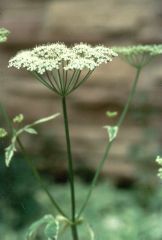
Identify family and key characteristics. Identify the genus and species if known.
|
|
|
Apiaceae
Compound umbel, polypetalous, sheathing leaf base, inferior ovary. Daucus carota |
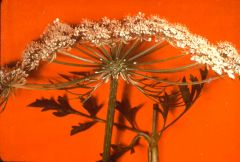
Identify family and key characteristics. Identify genus and species if known
|
|
|
Apiaceae
Sheathing leaf base |
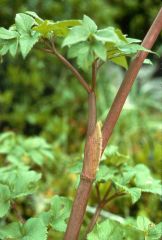
Identify family and key characteristics. Identify genus and species if known
|
|
|
Characteristics of caprifoliaceae
|
Caprifoliaceae Honeysuckle family (36 gen/810 spp) – “Cap” in MAD Cap Horse
1) mostly woody (some derived groups are herbaceous; eg, Valerianaceae and Dipsacaceae) 2) lvs opposite; usually simple, with no stipules 3) Flowers - zygomorphic (sometimes weakly so), sometimes bilabiate with 4 upper lobes/1 lower lobe (especially in Lonicera the honeysuckles) - 2-5 fused carpels, typically with one ovule per carpel and often with one or more ovules aborted; sometimes reduced to a single seeded fruit - ovary inferior Floral formula: X(*) 5, 5, 4-5, 2-5 berry, capsule, drupe, achene [carpels fused; ovary inferior] NOT monophyletic in traditional circumscription. Paraphyletic by exclusion of Adoxaceae, Valerianaceae, Dipsacaceae {together these make up the Dipsacales} |
|
|
Useful field characteristics of caprifoliaceae
|
herbs, shrubs, small trees, or lianas
leaves opposite, simple flowers zygomorphic petals 5, connate with 2 upper and 3 lower lobes, or 4 upper and 1 lower lobe; sometimes spurred 2-5 fused carpels ovary inferior; style elongate, stigma capitate nectar producing glandular hairs on inner surface of corolla tube berry, capsule, or drupe |
|
|
Caprifoliaceae.
Zygomorphic gamapet, inferior ovary, opposite leaves. Lonicera |

Identify family and key characteristics. Identify genus and species if known.
|
|
|
Caprifoliaceae
Weakly zygomorphic gamopet flowers with inferior ovary, opposite leaves. Linnaea |
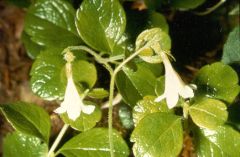
Identify the family and key characteristics. Identify the species if known
|
|
|
Caprifoliaceae
Weakly zygomorphic gamapet, inferior ovary, opposite leaves. Viburnum |

Identify the family and key characteristics. Identify the species if known
|
|
|
Characteristics of Scrophulariaceae.
|
Scrophulariaceae figwort family (269 gen/5100 spp, but….)
1) herbs or shrubs (ours usually herbs) (rarely with square stems, including Scrophularia!) 2) leaves usually alternate (some opposite); no stipules 3) many parasitic species – often segregated into family Orobanchaceae - hemiparasites - still capable of photosynthesis - holoparasites - without chlorophyll and completely dependent on their host 4) Flowers - zygomorphic; often bilabiate - didynamous stamens (2-long; 2-short); occasionally reduced to 2 - fruit a many-seeded capsule (occasionally a berry) |
|
|
Useful field characteristics of scrophulariaceae
|
usually herbs
flowers zygomorphic corolla sympetalous, bilabiate didynamous stamens usually present ovary superior; carpels 2, fused; ovules numerous capsule or berry |
|
|
Schrophulariaceae
2 stamens (reduced from 4) Veronica |
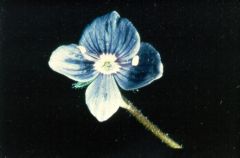
Identify the family and key characteristics. Identify the genus and species if known
|
|
|
Scrophulariaceae
Raceme, 5 bilabiate flower Digitalis |
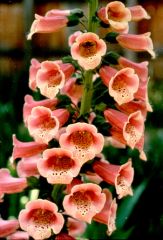
Identify the family and key characteristics. Identify the genus and species if known.
|
|
|
Schropularaceae
5 petal bilabiate flowers Mimulus |
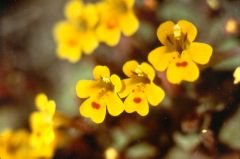
Identify the family and key characteristics. Identify the genus if known.
|
|
|
Scrophulariaceae
Zygomorhpic bilabiate flowers Penstemon |
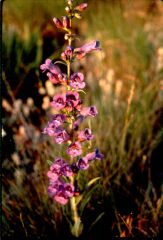
Identify the family and key characteristics
|
|
|
Violaceae 5 sepals and petals, bottom petal forming a nectary spur. Bottom two stamen nestled in spur, 3 fused carpels
|
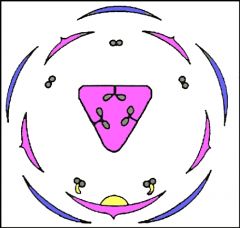
Identify the family and key characteristics
|
|
|
Violaceae 5 petals, chordate leaf bases.
|
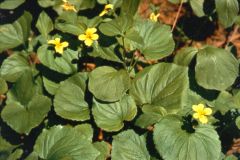
Identify the family and key characteristics. Identify the genus and species if known.
|
|
|
Violaceae Nectar spur and 2 stamens forming the nectary. Conniviant stamens.
|

Identify the family and key characteristics. Identify the genus and species if known.
|
|
|
Violaceae 3 fused carpels, parietal placentation
|
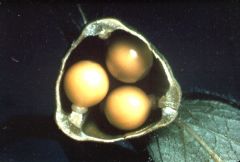
Identify the family and key characteristics. Identify the genus and species if known.
|
|
|
Useful field characteristics of Violaceae
|
usually herbs flowers zygomorphic corolla polypetalous (5), spurred nectar guides stamens connivent
|
|
|
Characteristics of Violaceae
|
1) mostly tropical trees(!); herbs in temperate zone 2) lvs simple (often cordate at base in violets) 3) Flowers zygomorphic (bilaterally symmetric) - petals 5, the lower one forming a ‘spur’ - stamens five, the lower two forming a nectary (held within the petal spur) - ovary superior; placentation parietal; 3-5 fused carpels
|
|
|
Asteraceae Flowers in head, this with purple ray and yellow disc flowers, involucre, alternate leaves
|
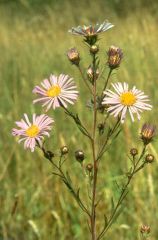
Identify the family and key characteristics. Name the genus and species if known.
|
|
|
Asteraceae Flowers in heads, ray and disk flowers, capitulum
|
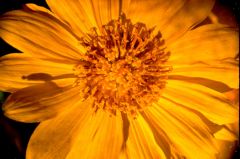
Identify the family and key characteristics. Name the genus and species if known.
|
|
|
Characteristics of Lamiaceae
|
Lamiaceae (Labiatae) - Mint family (258 gen/6970 spp)
1) woody/herbaceous 2) often aromatic – the large subfamily Nepetoideae characterized by aromatic oils instead of iridoids. These include many culinary herbs and ingredients in perfumes, including sage, rosemary, thyme, basil, lavender, etc. 3) stems often square (traditional herbaceous mints) 4) leaves usually opposite and decussate; sometimes whorled; no stipules 5) Flowers - zygomorphic; bilabiate (usually 2 upper lobes/3 lower lobes) - stamens and stigma usually enclosed in upper lip of corolla - stamens 2 or 4; often didynamous (2 uneven pairs) - gynoecium 2 carpels, each with 2 ovules and a false septum between ovules of each carpel; often with a gynobasic style arising from between 4 mericarps - fruit: schizocarp forming 4 nutlets (or a 1-4 seeded drupe) Floral formula: X 5, 5, 2 or 4, 2 nutlets or drupe [carpels fused] |
|
|
Useful field characteristics of lamiaceae
|
aromatic herbs
square stems leaves opposite or whorled flowers zygomorphic corolla sympetalous, bilabiate didynamous stamens gynobasic style (usually) ovary superior; carpels 2, fused; 2 ovules/carpel 4 nutlets (usually) |
|
|
Characteristics of Polemoniceae
|
1) herbaceous, sometime slightly woody at base (as in some species of Phlox)
2) lvs. simple usually alternate, sometimes opposite 3) flower morphology seems typical of traditional Asteridae s.s., but belongs here with other families traditionally placed in Dilleniidae - 1 whorl of stamens alternate with corolla lobes and adnate to corolla (this is probably from a loss of one whorl of stamens, but the similarity to core Asterids, such as Solanaceae, led to the classification of Polemoniaceae in Asteridae when its more closely related families with two whorls of stamens were placed in Dilleniidae) - 3 fused carpels - note 3-forked style; this is very unusual in traditional Asteridae, but this character is fairly common in families in this part of Asteridae s.l. (eg, Primulaceae, the primroses) - stamens unequally inserted on corolla tube Floral formula: * 5, 5, 5, 3 capsule[carpels fused] |
|
|
Useful field characteristics of Polemoniceae
|
usually herbs
flowers actinomorphic corolla sympetalous, convolute in bud unequal insertion of stamens on corolla carpels 3, connate stigmas separate (3) ovary superior |
|
|
Synapomorphies of Asterideae
|
1) Iridoid compounds – secondary chemical compounds thought to be plant defenses
2) Unitegmic ovules – ovules covered by a single integument (integument is the outer covering of the ovule, becomes seed coat) 3) Tenuinucellate ovules – thin nucellus in ovule (nucellus is the tissue beneath the integument that surrounds the megagametophyte) |
|
|
Core Asteridid characteristics
|
- gamopetalous corollas
- 5-parted flowers - a single whorl of stamens that alternate with the petal lobes - epipetalous stamens - 2 fused carpels |
|
|
Characteristics of Ericaceae
|
1) mostly trees and shrubs, some herbs
2) lvs simple often thick and leathery 3) plants often mycotrophic (nutritionally dependent on fungi underground, which, in turn are dependent on other green plants); some are totally without the ability to photosynthesize. Pine drops, Indian pipe, etc. 4) Flowers - actinomorphic (sometimes zygomorphic as in Rhododendron) - 5- parted perianth, usually connate - flowers often urn-shaped - 10 stamens (sometimes 5 in Rhododendron); anthers poricidal with terminal pores; attached to nectary disk (sometimes epipetalous) - 3-5 fused carpels; fruit a berry or capsule Floral formula: *(X) 5, 5, (5) 10, 3-5 berry, capsule [carpels fused] ovary usually superior, but sometimes inferior |
|
|
Useful field characteristics of Ericaceae
|
1) mostly trees and shrubs, some herbs
2) lvs simple often thick and leathery 3) plants often mycotrophic (nutritionally dependent on fungi underground, which, in turn are dependent on other green plants); some are totally without the ability to photosynthesize. Pine drops, Indian pipe, etc. 4) Flowers - actinomorphic (sometimes zygomorphic as in Rhododendron) - 5- parted perianth, usually connate - flowers often urn-shaped - 10 stamens (sometimes 5 in Rhododendron); anthers poricidal with terminal pores; attached to nectary disk (sometimes epipetalous) - 3-5 fused carpels; fruit a berry or capsule Floral formula: *(X) 5, 5, (5) 10, 3-5 berry, capsule [carpels fused] ovary usually superior, but sometimes inferior |
|
|
Characteristics of Boraginaceae
|
- Includes former Hydrophyllaceae
1) mostly herbs (all of ours); some shrubs and trees, mostly in tropics 2) lvs simple (sometimes deeply divided, eg, in Hydrophyllum), alternate, commonly with stiff ‘hispid’ hairs - Borago leaves demo 3) Flowers - actinomorphic - inflorescence a ‘scorpioid’ or ‘helicoid’ cyme (see below and overhead) - corolla often with a ‘corona’ of infolded appendages at throat of tube - stamens either exserted and spreading (former Hydrophyllaceae) or included - carpels 2, superior, exhibiting two distinct morphologies: 1) each with many ovules (formerly Hydrophyllaceae). 2) each containing 2 ovules and dividing by infolding of the ovary wall forming a false septum between each ovule (Boraginaceae s.s.). In our species this results in four separate ‘nutlets’ when mature (subfamily Boraginoideae, only). |
|
|
Useful field characteristics of Boraginaceae
|
herbs
plants often hairy leaves alternate scorpioid or helicoid cymes flowers actinomorphic corolla sympetalous style gynobasic OR terminal and bifid if style terminal and bifid, then stamens usually exserted ovary superior, 4-lobed (when gynobasic) OR unilocular 4 nutlets (when gynobasic) OR capsule |
|
|
Characteristics of Solanaceae
|
Potato or Nightshade family (150 gen/3000 spp)
This is one of the most important food plant families in the world, probably second only to the grass family. Includes potato, tomato, eggplant, peppers, tomatillo, naranjillo, tree tomato, and other crops locally grown in Latin America. 1) mostly herbs (some vines or woody plants) 2) lvs alternate, simple, often lobed 3) presence of alkaloids in various forms gives these plants various uses, including: culinary (capsaicin in chilis) medicinal (atropine in belladona) narcotic (nicotine in tobacco) hallucinogenic (various alkaloids in Datura - jimson weed) 4) Flowers - these flowers are often the most ‘generic’ Asteridae flowers - actinomorphic (some zygomorphic) - anthers not exserted, or if so, then connivent (held together) as in Solanum - style capitate (not divided) - carpels 2, fused, usually with many ovules.; fruit a berry or capsule Floral formula: *(X) 5, 5, (2, 4)5, 2 berry, capsule [carpels fused] examples of berry fruits: tomato, eggplant, chili pepper, and bell pepper |
|
|
Useful field characteristics of Solanaceae
|
usually herbs, shrubs, or vines
plants often densely pubescent leaves simple, alternate, commonly lobed flowers actinomorphic, sympetalous 2 carpels, capitate stigma ovary superior |

